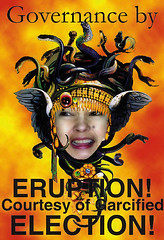Gloria Arroyo's Lies Not Even Close!
“I know much work remains to be done, but I am determined to turn over to a new government a new Philippines, one that is ready for the challenges bringing the nation to the verge of First World [status] in 20 years.” (GMA June 12, 2010).
This statement of GMA is clearly a hyperbolic claim that borders on an outright lie. As a trained economist she should know that given the more widespread access to data at present her claim can be easily checked against empirical facts.
It is a stylized fact in economics to consider the US and Japan as first world countries. So using these countries as benchmarks and a simple growth rates ratio index which compares the percent share of world product of a nation to its share of world population ( we refer to this henceforth as a gross rates ratio index or GRR index), let us check the viability of GMA's claim.
Taking data from our own central bank, the World Bank, the IMF and the CIA fact books, I made an estimate of the gross domestic product and population data of a few relevant selected countries. The GRR index scores are then computed to facilitate cross country comparisons. The process of computing index scores is a familiar tool in geomatics to reduce comparison factors to pure numbers so that standardization across geographic regions is achieved.
In the following table gross domestic product data is presented together with population figures for eleven countries and the resulting GRR index.
__________________________________________________________
__________________________________________________________
With a World Product estimate of about $ 61 Trillion in 2010 (my estimate, 2008 figures of the World Bank has a larger World Product but the financial crisis has since then shrank World GDP) Philippine GDP accounts for less than a third of one percent of total world product. Our own central bank estimates our share at .47 percent of world product after PPP (purchasing power parity) adjustments. I think there is a bit of window dressing here since PPP adjustments involves a lot of subjectivity. Without such adjustments, my own estimate places our share at just about .295 percent of world product.
In terms of population share we account for 1.3 percent of the 7 billion world population. Contrasting this with similar measures for the US we have the US share of world product at 25 percent while its share of world population is only 4.5 percent. The ratio of GDP share to Population share gives an index score for the Philippines at .22 while the equivalent GRR index score for the US is 5.5 . Using this index scale the difference of 5.5 to .22 gives us an idea of how far our state of economic development is from a first world country.
These GRR indexes of the US and the Philippines tell us that a person living in the united states is 25 times better off than a person living in the Philippines (0.22 divided into 5.5 = 25). Translated into a meaningful interpretation for US based Filipinos this index means that the average Filipino american is 25 times more economically potent than a Filipino in domecile in the Philippines.
Compared to our Asian neighbors Thailand has a population of 66 Million and a GDP of US 300 Billion for a GRR index score of .52; Malaysia has a 26 million population and a GDP of US 215 Billion for an index score of .95 ; and Indonesia with a population of 238 Million and a GDP of US 530 Billion has an index score of .26 which is still better than the Philippines. China with 1.5 billion people and a GDP of US 4.758 Trillion gets an index score of .36; While India with a population of 1.15 billion and GDP at US 1.243 Trillion has an index score of .12 . Japan has a population of 129 million and a GDP of US 5.32 Trillion for an index score of 4.73 ; Singapore has a population of only 5 million but has a GDP of US 190 billion ( bigger than the Philippines in absolute terms) and has an index score of 4.4 ; Korea has a population of 54 million and a GDP of US 842 billion.for an index score of 1.79 ; Taiwan has a population of 30.3 Million and a GDP of US 360 Billion for an index of 1.38. The computed Gross Rates Ratio index shows the Philippines as a cellar dweller only better off than India in these current year 2010. Singapore occupies an exalted position next only to Japan - the honored place the Philippines had in the 1950's.
What the GRR index tells us is that given a nation's share of the world's population, a score that is close to one like that of Malaysia in the table means that Malaysia is getting a proportion of world income flows that is almost equal to its percentage share of the world's population. Hence Malaysia is close to Unitary Balance while Thailand, China, Indonesia, the Philippines and India are in a development deficit status. These latter countries mentioned are getting a much lesser share of world income flows when compared to their share of the world's population. Comparing the GRR index results to that given by the HDI - Human development index of the UN, the rankings were almost identical. However in the HDI using 2008 data the UN ranked Japan higher than the US and the Philippines ranked a bit higher than Indonesia with India remaining at the bottom.
Using the GRR index we can roughly classify the eleven countries in our table as first world for those with an index above 1; second world for those close to 1 like Malaysia; and third world for those below .5 and close to 0. We can use the concept of unitary balance where the percent share of world population equals the percent share of world product to indicate second world status and among the non-first world countries in our set of eleven nations it is only Malaysia that has attained this.
Given the disparity in development among the eleven nations being discussed the relevant question apropos GMA's 20 year claim is how much should the Philippines have in population growth and GDP growth during that period to achieve first world status? second world status?
World product is estimated to grow at 4 percent a year. At this rate world product will be 134 trillion in 2030 at constant 2010 US dollars. The world’s population is also estimated to grow at 1.14 percent a year and is projected to to be 8.8 Billion people by 2030. Using the highest GDP growth rate of 7.3 percent per annum attained during GMA's governance we project Philippine GDP in 2030 to be 737 billion at constant 2010 US dollars. Since GMA was not able to tame Philippine population growth in her term we use the existing 1.9 percent growth and project Philippine population to be 137 million people by 2030. Deriving our GRR index using these projected figures our result is .353 only. This index score is way below unitary balance and therefore does not even allow us to classify the Philippines in 2030 as a second world nation. By 2030, with just following GMA's template and no radical changes in the way we manage our economy, we will be well below Malaysia in relative terms and clearly nowhere near 'the verge of first world status' that GMA claims.
Not even close.
___________________________________________________This statement of GMA is clearly a hyperbolic claim that borders on an outright lie. As a trained economist she should know that given the more widespread access to data at present her claim can be easily checked against empirical facts.
It is a stylized fact in economics to consider the US and Japan as first world countries. So using these countries as benchmarks and a simple growth rates ratio index which compares the percent share of world product of a nation to its share of world population ( we refer to this henceforth as a gross rates ratio index or GRR index), let us check the viability of GMA's claim.
Taking data from our own central bank, the World Bank, the IMF and the CIA fact books, I made an estimate of the gross domestic product and population data of a few relevant selected countries. The GRR index scores are then computed to facilitate cross country comparisons. The process of computing index scores is a familiar tool in geomatics to reduce comparison factors to pure numbers so that standardization across geographic regions is achieved.
In the following table gross domestic product data is presented together with population figures for eleven countries and the resulting GRR index.
__________________________________________________________
| country | gdp | pop | gdpshare | popshare | GRR Index |
| United States | 15000 | 315 | 0.24590 | 0.04500 | 5.464 |
| Japan | 5320 | 129 | 0.08721 | 0.01843 | 4.732 |
| Singapore | 190 | 5 | 0.00311 | 0.00071 | 4.361 |
| Korea | 842 | 54 | 0.01380 | 0.00771 | 1.789 |
| Taiwan | 360 | 30 | 0.00590 | 0.00429 | 1.377 |
| Malaysia | 215 | 26 | 0.00352 | 0.00371 | 0.949 |
| Thailand | 300 | 66 | 0.00492 | 0.00943 | 0.522 |
| China | 4758 | 1500 | 0.07800 | 0.21429 | 0.364 |
| Indonesia | 530 | 238 | 0.00869 | 0.03400 | 0.256 |
| Philippines | 180 | 94 | 0.00295 | 0.01343 | 0.220 |
| India | 243 | 1150 | 0.02038 | 0.16429 | 0.124 |
Based on 2009 and 2008 data projected to 2010 values. World Population 2010 (my estimates) 7 Billion. World Product US 61 Trillion. All GDP figures are in current US billion dollars.
Our 2008 GDP (gross domestic product - goods and services produced domestically in the Philippines) according to bangko sentral figures is $166.9 Billion US dollars. Growth in 2009 was just 1 percent on account of the world economic contraction. And with the election spending upward adjustments for 2010 growth were made up to 3.8 percent. Lately with strong first quarter growth of 7.3 per cent, private international groups adjusted their annual growth estimates to above 4.2 percent for the years 2009 to 2010. I used a 5 percent growth rate and forecast Philippine GDP to be about $180 Billion dollars for 2010. Population are in millions.
___________________________________________________________
With a World Product estimate of about $ 61 Trillion in 2010 (my estimate, 2008 figures of the World Bank has a larger World Product but the financial crisis has since then shrank World GDP) Philippine GDP accounts for less than a third of one percent of total world product. Our own central bank estimates our share at .47 percent of world product after PPP (purchasing power parity) adjustments. I think there is a bit of window dressing here since PPP adjustments involves a lot of subjectivity. Without such adjustments, my own estimate places our share at just about .295 percent of world product.
In terms of population share we account for 1.3 percent of the 7 billion world population. Contrasting this with similar measures for the US we have the US share of world product at 25 percent while its share of world population is only 4.5 percent. The ratio of GDP share to Population share gives an index score for the Philippines at .22 while the equivalent GRR index score for the US is 5.5 . Using this index scale the difference of 5.5 to .22 gives us an idea of how far our state of economic development is from a first world country.
These GRR indexes of the US and the Philippines tell us that a person living in the united states is 25 times better off than a person living in the Philippines (0.22 divided into 5.5 = 25). Translated into a meaningful interpretation for US based Filipinos this index means that the average Filipino american is 25 times more economically potent than a Filipino in domecile in the Philippines.
Compared to our Asian neighbors Thailand has a population of 66 Million and a GDP of US 300 Billion for a GRR index score of .52; Malaysia has a 26 million population and a GDP of US 215 Billion for an index score of .95 ; and Indonesia with a population of 238 Million and a GDP of US 530 Billion has an index score of .26 which is still better than the Philippines. China with 1.5 billion people and a GDP of US 4.758 Trillion gets an index score of .36; While India with a population of 1.15 billion and GDP at US 1.243 Trillion has an index score of .12 . Japan has a population of 129 million and a GDP of US 5.32 Trillion for an index score of 4.73 ; Singapore has a population of only 5 million but has a GDP of US 190 billion ( bigger than the Philippines in absolute terms) and has an index score of 4.4 ; Korea has a population of 54 million and a GDP of US 842 billion.for an index score of 1.79 ; Taiwan has a population of 30.3 Million and a GDP of US 360 Billion for an index of 1.38. The computed Gross Rates Ratio index shows the Philippines as a cellar dweller only better off than India in these current year 2010. Singapore occupies an exalted position next only to Japan - the honored place the Philippines had in the 1950's.
What the GRR index tells us is that given a nation's share of the world's population, a score that is close to one like that of Malaysia in the table means that Malaysia is getting a proportion of world income flows that is almost equal to its percentage share of the world's population. Hence Malaysia is close to Unitary Balance while Thailand, China, Indonesia, the Philippines and India are in a development deficit status. These latter countries mentioned are getting a much lesser share of world income flows when compared to their share of the world's population. Comparing the GRR index results to that given by the HDI - Human development index of the UN, the rankings were almost identical. However in the HDI using 2008 data the UN ranked Japan higher than the US and the Philippines ranked a bit higher than Indonesia with India remaining at the bottom.
Using the GRR index we can roughly classify the eleven countries in our table as first world for those with an index above 1; second world for those close to 1 like Malaysia; and third world for those below .5 and close to 0. We can use the concept of unitary balance where the percent share of world population equals the percent share of world product to indicate second world status and among the non-first world countries in our set of eleven nations it is only Malaysia that has attained this.
Given the disparity in development among the eleven nations being discussed the relevant question apropos GMA's 20 year claim is how much should the Philippines have in population growth and GDP growth during that period to achieve first world status? second world status?
World product is estimated to grow at 4 percent a year. At this rate world product will be 134 trillion in 2030 at constant 2010 US dollars. The world’s population is also estimated to grow at 1.14 percent a year and is projected to to be 8.8 Billion people by 2030. Using the highest GDP growth rate of 7.3 percent per annum attained during GMA's governance we project Philippine GDP in 2030 to be 737 billion at constant 2010 US dollars. Since GMA was not able to tame Philippine population growth in her term we use the existing 1.9 percent growth and project Philippine population to be 137 million people by 2030. Deriving our GRR index using these projected figures our result is .353 only. This index score is way below unitary balance and therefore does not even allow us to classify the Philippines in 2030 as a second world nation. By 2030, with just following GMA's template and no radical changes in the way we manage our economy, we will be well below Malaysia in relative terms and clearly nowhere near 'the verge of first world status' that GMA claims.
Not even close.
Related Articles from GRR:
- A Partnership for Progress
- Mobilizing Overseas Filipino Investment Remittance through a Philippine "Marshall Plan"
- The First 100 Days of Pres. Benigno C. AQUINO III
- Expectations from a Noynoy Aquino Presidency.
- One Hundred and a Thousand Days – then a Thousand More!
 Gil R. Ramos Ph.d. finished his Doctorate in Monetary Economics and Masters in Population Economics at the University of Hawaii. He did his AB Economics and also a Masters in Urban Regional Planning both at the University of the Philippines. He currently teaches MBA students at the (New Jersey City University) NJCU in Managerial Economics, Corporate Financial Management, and Managerial Information Systems. He runs his own consulting firm GRR Analytics based in the New York / New Jersey area.
Gil R. Ramos Ph.d. finished his Doctorate in Monetary Economics and Masters in Population Economics at the University of Hawaii. He did his AB Economics and also a Masters in Urban Regional Planning both at the University of the Philippines. He currently teaches MBA students at the (New Jersey City University) NJCU in Managerial Economics, Corporate Financial Management, and Managerial Information Systems. He runs his own consulting firm GRR Analytics based in the New York / New Jersey area.
POGB will not sell, exchange, use or allow any 3rd party access to your email for
any other purposes without exception, email exclusively for article updates only.
























0 Speak Out:
Post a Comment